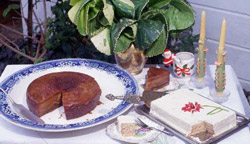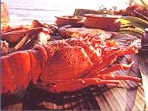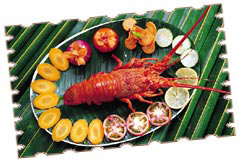 Situated
in the coastal areas of Goa, the staple food for all the Gians
is fish, irrespective of their religion. However Christian
Catholics are open to beef or pork too, which are a taboo
in most Hindu households due to their religious beliefs. Unlike
the Hindu Goan food, the Portuguese and its overseas settlements
heavily influence Christian recipes. 'Canjade Galinha', originally
a Goan recipe, is popular with them. It is a type of chicken
broth with rice and chicken pieces. A much-popular dessert
'Arroz Doce' is a Portuguese adaptation of Indian 'pais' or
'kheer' (sweetened rice). Goan cuisine is a unique blend of
Arabian, Portuguese and native foods with all their richness
and simplicity. Due to easy availability, fish and coconut
are used quite often in all the Goan delicacies. Situated
in the coastal areas of Goa, the staple food for all the Gians
is fish, irrespective of their religion. However Christian
Catholics are open to beef or pork too, which are a taboo
in most Hindu households due to their religious beliefs. Unlike
the Hindu Goan food, the Portuguese and its overseas settlements
heavily influence Christian recipes. 'Canjade Galinha', originally
a Goan recipe, is popular with them. It is a type of chicken
broth with rice and chicken pieces. A much-popular dessert
'Arroz Doce' is a Portuguese adaptation of Indian 'pais' or
'kheer' (sweetened rice). Goan cuisine is a unique blend of
Arabian, Portuguese and native foods with all their richness
and simplicity. Due to easy availability, fish and coconut
are used quite often in all the Goan delicacies.
The rural people of Goa often cook their
food on wood fires in clay pots and the smoky flavor of the
mid-day curry and the glass of fresh toddy are some of the
most treasured flavors of Goans. The peculiar ingredient that
render the uniqueness to authentic Goan cooking are coconut
as one of the main flavoring agents (as grated fresh coconut,
coconut ground into a fine paste, grated or powdered ripe
coconut or even in the form of coconut milk) and red, dried
chilies and peppers for the Goan fish and meat dishes. The
native Goan chili/pepper is large but not so fiery pungent
and is often replaced by Kashmiri chili/pepper, which can
more easily be found. Thus, it is advisable for the tourists
used to simpler food to check the spiciness of food before
tasting authentic Goan dishes that are often mentioned on
the menu cards of the restaurants as mild, moderate or spicy
hot.
Goan cuisine is a blend of different influences the Goans
had to endure during the centuries. The staplefood in Goa
is fish, both among the Hindus as well as the Catholics. On
other fronts however, there is a vast difference in the foods
of these two communities, the main reason being that the Christians
also eat beef and pork which are taboo in most Hindu households.
While Hindu Goan food does not seem to have picked up any
Portuguese influence, the Christian food has been influenced
not only by the Portuguese, but also by its overseas settlments.
However, it has not been a oneway transfer. An example is
canjade galinha , which is a type of chicken broth with rice
and chicken pieces, and is originally a Goan recipe. Another
is arroz doce , which is a Portuguese adaptation of pais or
kheer (sweetened rice) found in India. |
Successful Goan Home Wines - Book Review and Three wine Recipes
 Successful Goan Home Wines Successful Goan Home Wines
By Edwin Saldanha
PP 143 (2001) Rs.80
This book exposes to amateurs the closely "guarded secrets by many cultures". Home made wines of Goa imbibe the knowledge of eastern and western traditions. User friendly instructions to successful wine making at home, using simple ingredients.
Taste the best Frederick Noronha
An octogenarian wine-maker from Goa, Edwin Saldanha, who has published a book offering all the secrets of making wine, believes that a tiny bit of wine is healthy, especially after one crosses two-score and ten Saldanha has authored the book Successful Goan Home Wines. His advice: a small 40 to 60 milliliter peg, taken at food time, and well diluted for those above 50. This, he believes, could help improve digestion and circulation. "My book is the only one in the whole world that tells you how to make wine from tropical fruits," he says. It has recipes on how to make wine from mangoes, bananas, cashews, and even kokum and jambul.
"I've make wine from everything. A lady-journalist asked me what I make wine from." The old man who has been making wine from the age of 13, told her, "Just about everything; even soles of old shoes!"
Goa had a tradition of affluent women closely guarding secrets on making wine. "They don't sell it, but only use it for festivals and feasts." But he believes adulteration is ruining Goa's traditional liquors, including the potent and strong-flavored brew feni.
 THREE WINE RECIPES: FROM A BOOK BY EDWIN SALDANHA THREE WINE RECIPES: FROM A BOOK BY EDWIN SALDANHA
Wine is the fermented, pure, poetic essence of mother nature. Wine is revered in religious rituals. Secrets of successful wine making, a very ancient art, are closely guarded by many cultures. However, this book, for the first time in India, exposes these secrets to amateurs through Eddy Saldanha's time-tested recipes. Home-made wine of Goa imbibe the knowledge of eastern and western traditions. Eddy's user-friendly instructions lead your way to successful wine-making at home, using simple ingredients.*Successful Goan Home Wines, by Edwin Saldanha (a former teacher of St. Britto's and Scoutmaster, who died a couple of years ago) is published by Rajhauns
APPLE WINE
- Here's one apple wine. You will love it. You will need:
- 2 lemons
- 10 gms yeast
- 2 gms KMS (potassium metabisulphite)
- 4 kgs apples, any cheaper type will do
- 2 kgs sugar
- 6 litres boiling water
- 250 gms raisins, chopped
METHOD: Chop the apples with the skin after washing them. Boil for 15minutes with thinly peeled rind of lemons. Strain the liquor over the sugar. Stir well and cover. When the liquor is lukewarm, add the activated yeast.
Add the strained juice of lemons, cover and leave for 24 hours. Next day, pour into a large jar and stand in a warm place for about seven days. When the fermentation has ceased, put the raisins in a clean dry storage jar.
Siphon the wine over the raisins. Leave it for maturing for four months. Rack and bottle after adding the 2 gms of KMS
BANANA WINE
- This wine can be made sweet or dry.
- You will need:
- 1.5 kg bananas, about six large ones.
- 4 gms KMS (potassium metabisulphite)
- 1 kg sugar for dry, or 1.5 kg for sweet wine
- 250 ml freshly made strong tea
- Strained juice of two lemons or three gms citric acid
- 100 gms yeast
- Five litres water
METHOD: Boil the bananas in two liters of water and mash them. When boiling add 1/2 of the sugar. When lukewarm, add two gms KMS, tea and the lemon juice. Do the pulp fermentation in a bucket. After four days strain the mixture through a cloth in to a fermentation jar. Add the remaining sugar, stir and add the yeast. Add the remaining water, boiled and slightly warm (lukewarm) and stir. Keep for fermentation for 21 days or until bubbling has stopped. Rack three times and bottle after three months. Mature for at least six months. Don't forget to add 2 gms KMS after each racking
BHINDA WINE
These semi-wild fruits are available in plenty. If you or your neighbor has a binda tree, collect the fruit previously fallen on the ground. You may add this to those shaken down from the tree. Use only the ripe fruit and discard the over-ripe and red inside.
You will need:
- 4 kgs bhinda shells
- 3 kgs sugar
- 400 gms wheat
- 10 gms or 3 teaspoons yeast
- 4 gms KMS
- 6 litres boiling water
- 2 t.s. tea leaves
METHOD: Remove the seeds, after cutting open the fruit. Keep the red shells with some white pulp. Throw away the seeds. Pour boiling water over it and add 2 gms KMS. Keep for 24 hours. Strain the juice in to the fermentation jar. Add 1 1/2 kg sugar, wheat, just washed but not crushed, tea leaves and yeast. Keep for eight days to ferment. On the 9th day, add the remaining 11/2 kg sugar. Let it ferment for another 10 days. All this time, keep on stirring every alternate day. After 21 days, siphon the clear wine leaving the solids which are to be discarded. Rack after 48 hours and bottle after adding two gms KMS.[NOTE ON RACKING: Wine could be entirely lacking in vinosity and would develop off flavors if it was not periodically separated from its deposits. This is called racking. Racking is best done with a siphon, when fermentation has stopped i.e. after about 21 to 24 days, may be sometimes earlier or later, depending on when the fermentation has stopped.
After sedimentation, keep the wine to settle for 48 hours, and the first racking is done. If the wine is clear, add KMS and bottle. But if not clear, leave the wine in the jar for three weeks more, by times time it will be clear. If still not clear, the wine may be kept for three months before racking. Even three racking are not too many before bottling. Racking helps to ensure that the wine will be in sound condition before maturing. Every time you rack, add sufficient quantity of KMS. Do not keep the fermented wine too long without tracking, or else the wine will be turbid, or it may even spoil. This turbidity is almost impossible to remove .It is unwise to rack an actively fermenting wine. The sediment in the fermentation jar consists of fruit pulp and dead yeast. This must be removed before it putrifies and taints the young wine.
--NOTE: KMS is potassium metabisulphite. It is also used to sterilize wine-making equipment (dissolving 10 gms in one litre of cold water). Always wash the fruit and add the required amount of KMS as soon as it is mashed, Unless hot water is being used. Always add the required amount of KMS when racking. |
 Coconut
milk is an essential ingredient in Goan cooking. It can be
prepared by grating the white flesh of a coconut and soaking
it in a cup of warm water. ‘Kokum', a sour, deep red
colored fruit that has a sharp and sour flavor is an equally
important ingredient. The famous red Goan chilies are also
added to most dishes, and so tamarind. Goans have their own
peculiar version of vinegar that is mage from toddy. There
are also innumerable spicy and tangy chutneys that are characteristic
of the state In the tropical South heavy use of coconut milk,
an ingredient rarely seen in the North is used. Areas with
access to waterways depend on seafood the food of Goa has
a great influence of Portuguese rule. Goans eat pork and duck,
meats rarely seen outside the area, and use vinegar as a souring
agent.
 |
Goan Vindaloo (Pork)
Ingredients
1 kg lean pork cleaned
10 cloves garlic
1 inch piece ginger
10 dried red chillies/peppers
10 peppercorns
8 cloves
1 inch piece cinnamon
1 tsp cumin seeds
½ mustard seeds
2 medium onions, chopped fine
½ tsp sugar
½ tsp vinegar
2 tbsp oil
½ peg coconut feni
2 cups water
Salt as per taste |
Method:
Cut the cleaned pork into ½ inch sized pieces. Apply
salt and keep aside. Grind all the spices and blend it with
vinegar, adding the ½ tsp sugar. Apply the ground spices
to the meat and marinate for 3 hours. Heat the oil in the
pan on medium heat and add the meat. Fry the meat for few
minutes, then add the chopped onion, coconut feni, rest of
the vinegar and the water gradually. Cover the pan and lower
heat. Stir cook till meat is tender and the oil rises to the
top.
Galinha Cafreal
Ingredients
1 large chicken (1¼ kg) jointed
6 green chillies/peppers
1 ¼ inch piece ginger
10 cloves garlic
1 tbsp coriander seeds
1 tsp cumin seeds
½ tsp garam masala
1 tbsp lemon juice
3 tbsp oil
2 medium onions, chopped fine
4 large tomatoes, halved
6 medium potatoes, boiled, halved
Salt as per taste
Method: Grind to a fine
paste, the ginger, garlic and all the spices in the lemon
juice, including the green chillies/peppers and half chopped
onions, adding salt as per taste. Joint the chicken and apply
the ground spices to the chicken pieces. Marinate the chicken
for 2 hours. Heat oil in a pan on medium flame and saute the
rest of the chopped onion. Fry the chicken turning them over
both the sides till the pieces are browned and cooked (approx.
20 mins). In a separate pan: heat 1 tbsp oil and fry potatoes
and then very lightly the halved tomatoes. Serve the chicken
with the fried potatoes and tomatoes.
Goan Sambharachi Kodi (prawn curry)
Ingredients
100 gm peeled prawns
100 gm dried prawns
4 onions
3 coconuts, grated
20 bilimbis
5 mango seeds (padde)
Walnut sized ball of tamarind
1 inch piece ginger
6 flakes garlic
6 green chillies
1 tbsp sugar
4 maggi cubes
2 tbsp oil
4-5 tbsp Goan sambhar masala
Salt as per taste
Method: Mix the dried and
fresh prawns together, salt and keep aside. Slice the bilimbis,
add a handful of salt and let it drain. Heat 2 tablespoons
of oil in a pan. Crush the ginger and garlic and fry over
slow fire in the heated oil. Slice the onions, and fry along
with the ginger and garlic, till brown. Remove the mixture
in a bowl and keep aside. Fry the blimbis in the remaining
oil in the pan till they change color. Remove from the pan
and keep aside. Add ginger and garlic and fried onions back
to the pan. Add the prawns, mango seeds and green chillies
and fry. Extract thick coconut juice and keep aside. Then
take about 1½ litre of thin juice. Take 4 to 5 tablespoons
of the above sambhar masala and blend well with the coconut
juice. Add it to the prawn mixture in the pan and let it boil
well for about half an hour. Then add the thick coconut juice,
bilimbis, sugar, maggi cubes and ½ cup tamarind water.
Let the mixture cook well. Add salt and sugar if necessary.
|




